What Is Better, Sauna or Steam Room? Examining the Differences for Your Wellness Routine
When it comes to enhancing your wellness routine, both saunas and steam rooms offer many potential health benefits. These two heat therapy options, while similar in some aspects, provide distinctly different experiences.
Saunas, with their dry heat and low humidity, have been a staple in Scandinavian culture for centuries. On the other hand, steam rooms, characterized by their moist heat and high humidity, trace their roots back to ancient Roman and Turkish bathing traditions.
In this article, we'll learn the intricacies of these two heat therapy modalities (sauna and steam room), exploring how they work, potential health benefits, and practical aspects to help you make an informed decision.
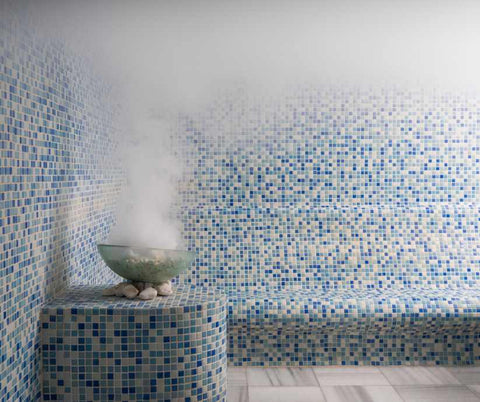
What are Saunas?
Saunas are a staple in various cultures around the world, celebrated for their relaxation and health benefits. Originating in Finland over 2,000 years ago, saunas have evolved from simple earth pits to sophisticated facilities found in modern homes and health clubs.
Characterized by their dry heat, saunas typically operate at average sauna temperatures between 150°F and 195°F (65°C and 90°C), with very low humidity, usually under 10%. This environment is created by heating stones or a stove in the room, which then radiates the heat throughout the space.
Types of Saunas
The sauna experience can vary significantly depending on its type. The traditional Finnish sauna, known for its wood-lined walls and wood-burning stove, offers a rustic and earthy experience. Electric saunas, which use an electric heater to warm the sauna rocks, provide a more consistent and easily controlled environment.
Infrared saunas, a more modern innovation, use infrared heaters to directly warm the body without significantly increasing the air temperature, making it a suitable option for those who might find traditional saunas too intense.
Traditional Finnish Saunas: Use a wood-burning stove to heat stones. Water is occasionally thrown on the hot rocks to produce steam and increase humidity momentarily, enhancing the heat sensation.
Electric Saunas: Employ an electric heater to warm the room, offering a more controlled and consistent heat. Electric sauna heater with rocks are common in residential and commercial facilities for their ease of installation and use.
Infrared Saunas: Instead of heating the air, infrared saunas use infrared lamps to warm the body directly. An infrared sauna operates at a lower temperature range, usually between 120°F and 140°F (49°C to 60°C), making it accessible for those sensitive to higher temperatures.
How Saunas Work
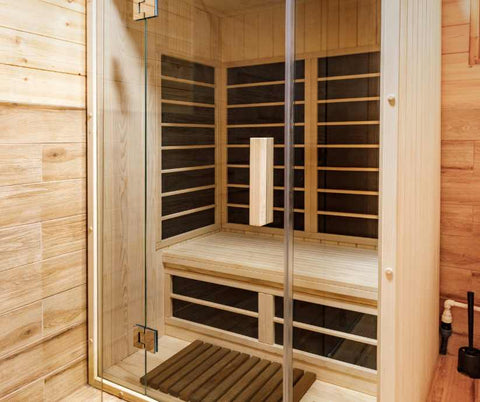
The principle behind saunas is simple: a heat source warms the air, and the hot air raises the temperature of the skin and core body temperature, prompting sweating. This process provides many potential sauna health benefits. It is known to relax muscles, open up pores, and encourage a deep sense of relaxation.
The dry heat in saunas facilitates an intense sweat session, believed to help in flushing out toxins and cleansing the skin.
Cultural Significance
In many cultures, particularly in Finland, saunas transcend mere relaxation and are ingrained in social and family traditions. They are places of communal gathering, relaxation, and even spiritual cleansing.
The Finnish concept of "löyly," which refers to the steam and the atmosphere in the sauna, is considered an essential part of the sauna experience, highlighting the holistic and immersive nature of this tradition.
Health Considerations and Potential Sauna Benefits
Saunas are praised for a variety of potential health benefits, from improved cardiovascular function to stress relief and muscle recovery.
Heat exposure helps dilate blood vessels, improving circulation and lowering blood pressure. It's also thought to aid in muscle relaxation and recovery post-exercise by increasing blood flow to tired and sore muscles.
Regular sauna use has been linked to a reduced risk of certain chronic diseases and conditions, though it's important to use them responsibly, especially for individuals with pre-existing health conditions.
RELATED TO: Steam Room vs Sauna: Which One Should You Choose for Relaxation and Detoxification?
What are Steam Rooms?

Steam rooms, often associated with ancient Roman baths, have been a part of wellness and relaxation practices for centuries. Unlike the dry heat of a traditional sauna, steam rooms provide a moist heat environment with high humidity levels, typically close to 100%.
Operating at lower temperatures than saunas, usually between 110°F and 120°F (43°C to 49°C), steam rooms envelop occupants in a warm, therapeutic mist, offering a different set of benefits and experiences.
How Steam Rooms Work
The core feature of a steam room is its ability to generate steam. This is achieved through a steam generator that boils water into steam, which is then released into the sealed room.
The walls, often made of non-porous materials like tile or stone, are designed to withstand the moist environment. The combination of heat and humidity in steam rooms opens up pores, loosens stiff joints, and can help clear the respiratory system.
Potential Steam Room Benefits
Steam rooms are celebrated for their ability to promote relaxation and improve skin health. The high humidity in a steam bath is particularly beneficial for the respiratory system. Inhaling steam aids in the alleviation of congestion and making it easier to breathe.
The warm environment in using steam rooms regularly is also known to soothe muscle soreness and joint pain, making it a popular choice post-exercise. Moreover, the steam helps to cleanse the skin by softening the surface layer and opening pores, which facilitates the removal of dirt and dead skin cells.
Types of Steam Rooms
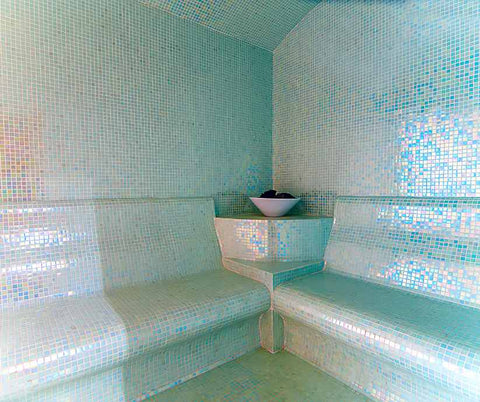
While the basic principle of steam rooms remains consistent, there are variations in design and construction:
-
Traditional Steam Rooms: These are often found in spa and gym settings, featuring tiled walls and benches, with a steam generator that pumps steam into the room.
-
Hammam or Turkish Baths: A variation of the steam room, Hammams are part of a traditional Turkish bathing culture, offering a sequence of rooms with varying temperatures and humidity levels for a comprehensive cleansing and bathing ritual.
-
Home Steam Showers: With advances in technology, steam generators can now be installed in residential showers, allowing for a steam room experience at home. These units can transform a regular shower into a steam shower or steam room at the push of a button, offering convenience and privacy.
Cultural and Social Aspects
In many cultures, steam rooms serve as communal spaces for relaxation and social interaction, similar to the role of saunas in Finnish culture.
The communal aspect of steam rooms is particularly pronounced in the Middle Eastern Hammams, where the bathing ritual is often accompanied by traditional body treatments and massage, emphasizing the social and communal nature of the experience.
Precautions and Recommendations
While steam rooms offer numerous health benefits, it's essential to approach their use with caution, especially for individuals with cardiovascular issues or those who are pregnant.
The high humidity can make it feel hotter than it actually is, increasing the risk of overheating or dehydration. It's recommended to limit sessions to 15-20 minutes and to stay hydrated before and after using a steam room.
Potential Health Benefits of Saunas and Steam Rooms
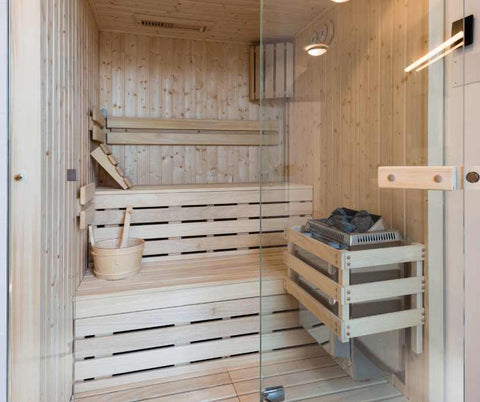
Saunas and steam rooms, each with their distinct environments, offer a range of health benefits that can complement a wellness routine.
While saunas provide dry heat, steam rooms offer a moist heat setting, and both have unique advantages for physical and mental health.
Cardiovascular Health
-
Saunas: Regular sauna sessions have been associated with a lower risk of cardiovascular diseases, including heart disease and high blood pressure. The heat from saunas causes the blood vessels to dilate, improving circulation and potentially lowering blood pressure.
-
Steam Rooms: Similar to saunas, the warm environment of a steam room can also promote cardiovascular health by improving circulation. The humid air helps to open blood vessels, which can aid in lowering blood pressure and improving heart health. While research on steam rooms is less extensive than on saunas, the principles of heat therapy suggest comparable benefits for cardiovascular function.
Muscle Recovery and Pain Relief
-
Saunas: The heat from saunas helps to relax muscles and relieve tension, which can be particularly beneficial after strenuous exercise. The increased blood flow to muscles may aid in recovery and reduce muscle soreness. Athletes often use saunas as part of their post-workout routine to enhance muscle recovery.
-
Steam Rooms: The moist heat in steam rooms is also effective in relaxing muscles and alleviating joint stiffness. People with arthritis or chronic pain may find relief in the warm, humid environment of a steam room, as it can help reduce inflammation and ease pain.
Immune System Boost
-
Saunas: Exposure to the heat of a sauna can stimulate the production of white blood cells, which play a key role in fighting off infections. Regular sauna sessions can potentially lead to an improved immune response, as suggested by some studies that have observed a decrease in the incidence of colds and flu among regular sauna users.
-
Steam Rooms: The warm, moist air in steam rooms can also support the immune system, particularly by improving respiratory function. Breathing in steam can help clear the sinuses and lungs, which may help prevent respiratory infections and improve overall respiratory health.
Mental Health and Relaxation
-
Saunas and Steam Rooms: Both saunas and steam rooms offer a tranquil environment that can help reduce stress and promote relaxation. The heat helps to release endorphins, the body's natural "feel-good" hormones, which can elevate mood and create a sense of well-being. Many people find the quiet, warm environment conducive to meditation and mindfulness practices, further enhancing mental health benefits.
-
Steam rooms and saunas can potentially boost the soothing effects by adding eucalyptus oil or other essential oils to the water.
Skin Health
-
Saunas: The dry heat in saunas can help cleanse the skin by opening pores and promoting sweating, which helps to flush out toxins and impurities. Regular sauna use can lead to clearer, healthier-looking skin over time.
-
Steam Rooms: The high humidity in steam rooms is particularly beneficial for the skin, as it helps to hydrate and soften the skin's surface. The steam helps to open pores, allowing for deeper cleansing and potentially aiding in the treatment of acne and other skin conditions.
Incorporating saunas or steam rooms into a wellness routine can offer a range of health benefits, from improved cardiovascular health and muscle recovery to enhanced mental well-being and skin health.
Whether choosing the dry heat of a sauna or the moist warmth of a steam room, it's important to consider individual health conditions and preferences to maximize the potential benefits while minimizing risks.
Sauna vs Steam Room Session: Accessibility and Ease of Use
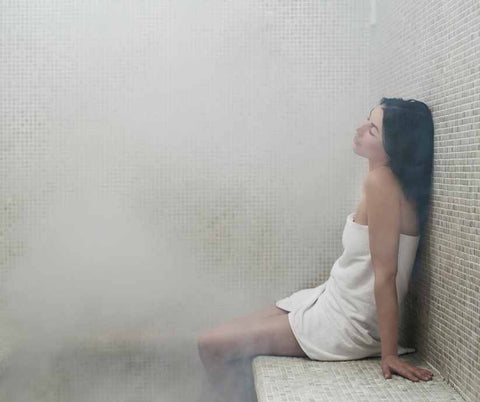
When considering incorporating saunas or steam rooms into a wellness routine, understanding their accessibility and ease of use is important. These factors can significantly influence the decision-making process and overall experience.
Availability in Public Facilities
Saunas: Saunas are a common feature in many gyms, health clubs, and spas. They are often preferred for their relatively simple maintenance and the dry heat they offer, which is suitable for a wider audience, including those who may find the humidity of steam rooms uncomfortable.
Steam Rooms: Steam rooms, while also prevalent in health clubs and spas, might be slightly less common than saunas in some regions due to the more complex maintenance required to manage the high humidity levels and ensure a hygienic environment.
Installation in Residential Settings
Home Saunas: The popularity of saunas at home is on the rise, with options ranging from pre-built units to custom installations. Infrared saunas, in particular, are favored for their ease of installation and operation, as they can often be plugged into a standard electrical outlet and do not require special ventilation systems.
Home Steam Showers: Transforming a regular shower into a steam shower is a viable option for those looking to enjoy steam room benefits at home. This typically involves installing a steam generator and ensuring the space is adequately sealed to prevent moisture damage.
While more involved than setting up a home sauna, modern technology has made the benefits of steam showers an accessible luxury for many homeowners.
Operational Considerations
Ease of Use: Both saunas and steam rooms are relatively easy to operate in public facilities, with most offering user-friendly controls for temperature and steam.
In home settings, saunas, especially infrared saunas, tend to be simpler to use and maintain, with straightforward temperature settings and minimal upkeep.
Maintenance: Saunas generally require less maintenance than steam rooms, mainly due to the lower humidity levels, which reduce the risk of mold and mildew growth. Regular cleaning of the benches and floor, along with occasional wood treatment, is typically sufficient. It's important to know how to clean a sauna for proper hygiene and to prevent infections.
Steam rooms, due to their moist environment, necessitate more frequent cleaning and ventilation to prevent mold, making their maintenance more labor-intensive.
Safety Guidelines and Best Practices
Health Considerations: Both saunas and steam rooms come with health advisories. It is recommended to limit sessions to 15-20 minutes and ensure proper hydration before and after use. Individuals with specific health conditions, such as heart problems or pregnancy, should consult a healthcare provider before use.
Hygiene: In public facilities, personal hygiene is paramount to prevent the spread of infections. Sitting on towels and wearing flip-flops can minimize direct contact with surfaces. In home settings, regular cleaning and maintenance are essential to ensure a hygienic environment.

In Summary
In the pursuit of wellness, both saunas and steam rooms offer unique benefits that can significantly enhance your overall health and well-being. While saunas provide a dry heat environment that promotes relaxation, detoxification, and improved cardiovascular function, steam rooms offer a moist heat setting that supports respiratory health, skin hydration, and muscle recovery.
The choice between a sauna and a steam room comes down to personal preference and individual health needs. Those who enjoy a more intense, sweat-inducing experience may gravitate towards the dry heat of a sauna, while others who prefer a gentler, more humid environment may find solace in a steam room.
Accessibility and ease of use are also important factors to consider when incorporating heat therapy into your wellness routine. With the increasing availability of home saunas and steam showers, along with their presence in public facilities like gyms and spas, engaging in regular heat therapy sessions has become more convenient than ever.
